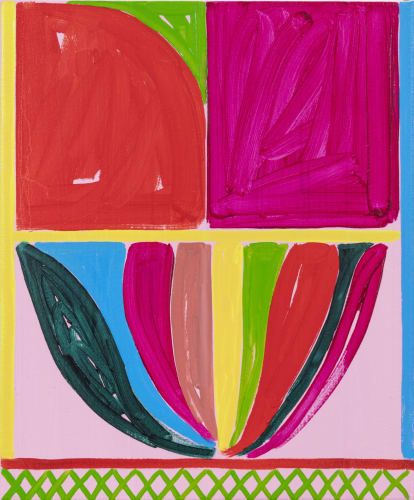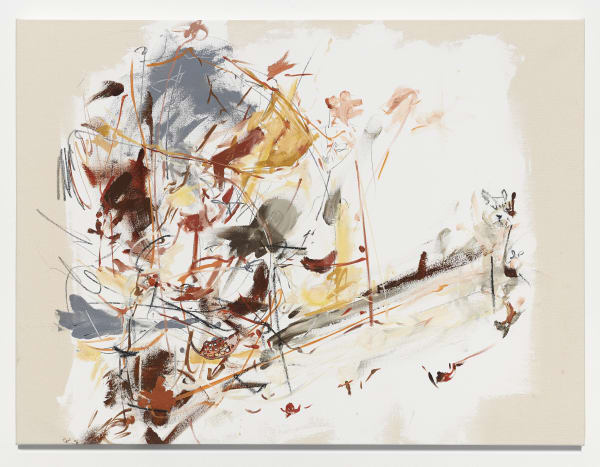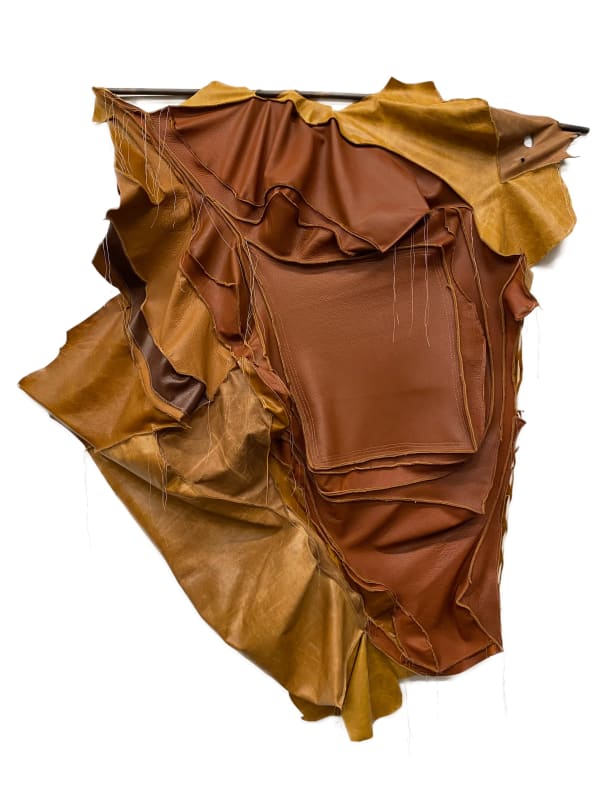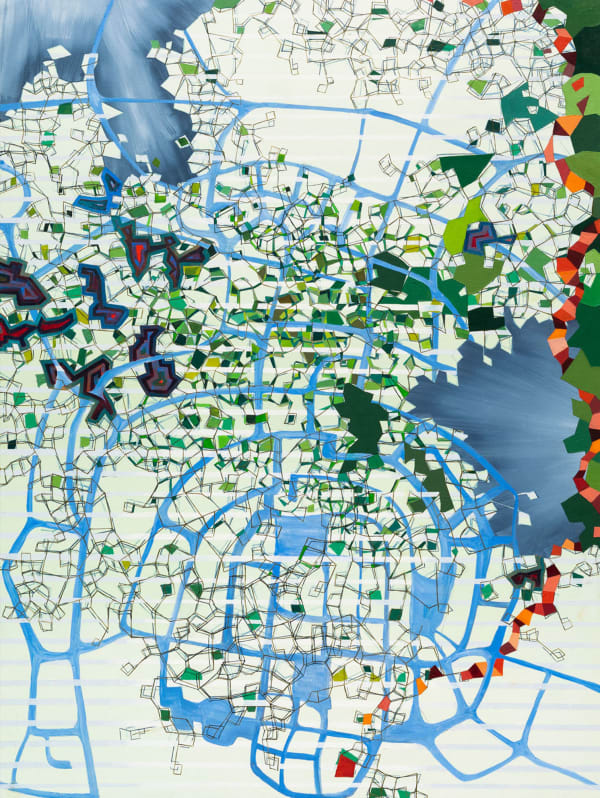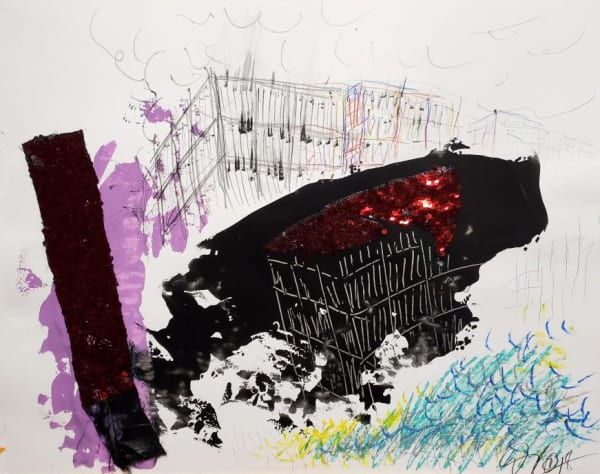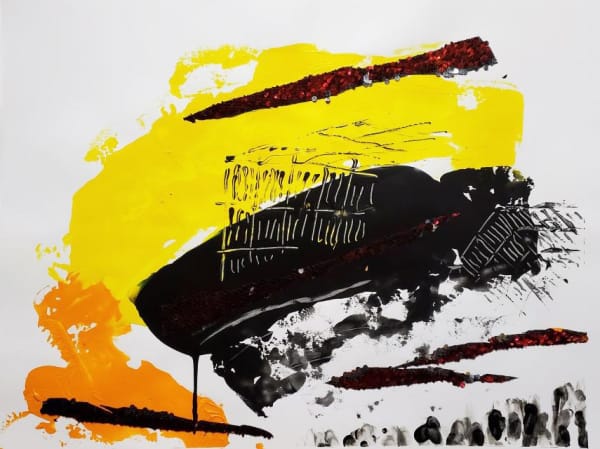What's It All About: Anthony Olubunmi Akinbola, Patrick Alston, Carmen Neely, Esteban Ramón Pérez, Emma Soucek, Jason Stopa, Dewey Crumpler and Lisa Corinne Davis
By Appointment Only: Jenkins Johnson Projects, New York, is pleased to present What’s It All About. A group exhibition featuring the works Anthony Olubunmi Akinbola, Patrick Alston, Carmen Neely, Esteban Ramón Pérez, Emma Soucek, Jason Stopa, Dewey Crumpler and Lisa Corinne Davis. The exhibition will have an accompanying essay by Writer and Critic Amarie Gipson. What’s It All About brings together a focused selection of works by a multigeneration group of artists all considering abstraction within their practice.
On Friday, August 13th, we held our 24th installment of Conversations on Culture featuring the artists from What's It All About moderated by Amarie Gipson. This conversation can be viewed here.
Jenkins Johnson Projects, New York, is pleased to present What’s It All About, an exhibition of muligenerational artists, whose abstract work is being created in the first part of the 21st century, a period of dramatic change and shifting global dynamics. The exhibition features renowned professors Dewey Crumpler, San Francisco Art Institute, and Lisa Corinne Davis, Hunter College. Participating artists also include Anthony Olubunmi Akinbola, Patrick Alston, Carmen Neely, Esteban Ramón Pérez, Emma Soucek and Jason Stopa.
Events with artists throughout the show will include Instagram Takeovers and a Conversations on Culture with Amarie Gipson, Writer and Critic on Saturday, August 14, 2021, at 3:00 PM Eastern Time via Zoom. The exhibition is accompanied by an online essay by Amarie Gipson.
What’s It All About is an interaction between artists exploring abstraction. The artists use painting, sculpture and assemblage to investigate color, form, movement, rhythm, spirituality, history, identity, cultural and social issues. Each approaches their practice differently, utilizing abstraction to convey personal messages and ideas. Davis and Crumpler’s works demonstrate their breadth of experience in abstraction, informing the experimentations and investigations of the group at large. Within the exhibition viewers can weave between new ideas towards traditional exploration of formal elements, and contemporary usage of found object as collage. Pérez, Akinbola and Soucek both create assemblages on canvas, preferring materials such as leather, durags, upholstery and paper pulp. Alston combines formal painting with found objects and traditional mark making. Stopa explores the boundary between abstraction and architecture, while Neely translates memories and experiences into lyrical gestures on canvas.
Dewey Crumpler (b. 1949, San Francisco, CA) is a multidisciplinary artist who examines issues of globalization and cultural commodification through abstract and representational painting, video and installation works. Two of the paintings on canvas in the exhibition, Blue Mist and Bright Moments, are from his Visual Rhythm series, and examine powerful structures that frame social interpretations. Re-contextualizing symbols such as top hat, he examines Black consciousness. Mimicking the top hat, a symbol of white sophistication, ex-slaves developed a dance called the Cakewalk transforming this elitist symbol into a vehicle for mockery. The dance was adapted by whites, unaware of its sarcastic intent, and led to the Lindy Hop and the Charleston dance crazes. Crumpler’s series is also influenced by rhythm and blues, rock and roll, bebop, hip hop and jazz greats including Miles Davis, Thelonious Monk, and John Coltrane.
Crumpler’s grids reflect the structures that metaphorically hold our world together; his grids transform from barrier to agents of change, creating rhythms of endless angles, perspectives, and shadows. While we rely on the “grid” to interpret our world, Crumpler reminds us of its instability.
Crumpler has an upcoming survey at The Richmond Arts Center. He is in permanent collections including the Oakland Museum of California; the Triton Museum of Art, CA; and the California African American Museum. His work was in Tate Modern’s Soul of a Nation. He has received many awards, including the National Endowment for the Arts Fellowship Grant. He lives and works in Berkeley, California.
Lisa Corinne Davis (b. 1958, Baltimore, MD) uses abstraction to explore race, culture, and history, challenging classification and contingency. Her art depends on the idea that nothing is concrete, but rather a “subjective construct of culture, biases, assumptions, and personal predispositions.”
Davis is currently Professor of Art, Co-MFA Director, Head of Painting at Hunter College in New York. Her work is in institutions including The Museum of Modern Art, New York; J. Paul Getty Museum, Los Angeles; and Victoria and Albert Museum, London. She is the recipient of many awards including the 2021 Arts and Letters Award in Art from the American Academy of Arts and Letters, the Pollock-Krasner Foundation Grant, the National Endowment for the Arts' Visual Artist Fellowship, and three New York Foundation for the Arts Visual Arts Fellowships. Davis' work has been reviewed by periodicals such as The New York Times, Art in America, ArtNews and Hyperallergic. Davis lives and works in Brooklyn and Hudson, New York.
Anthony Olubunmi Akinbola (b.1991, Columbia, MO), A first-generation American raised in Missouri and Nigeria, Akinbola reimagines the construction of identity through startling original treatments of color and texture. Foregoing conventional approaches to painting and sculpture, Akinbola’s self-developed techniques explore the possibilities of totemic materials like palm oil, hairbrushes, and durags—fiber scarves used in the maintenance of Black hair. Characterizing his works as “metaphors for what a first-generation existence might look like,” Akinbola unpacks the rituals and histories separating Africa from Black America. His multifaceted compositions celebrate and reconcile diverse cultural narratives, creating multilayered works of art that engage consumption, respectability, and the commodification of Black culture. Camouflage #48 (Piccolo), Akinbola refers to his assemblages of durags as paintings, representing a part of Black culture that has gone unrecognized by the art world. His works in the show also illustrate how the durag has evolved from its original color black. Akinbola’s work has been shown at the Museum of Arts and Design, the Queens Museum, New York and the Zuckerman Museum of Art, Georgia. He recently completed a solo exhibition at the John Michael Kohler Arts Center.
Patrick Alston (b. 1991, the Bronx, NY) energetically creates works that, along with the interplay of titles, trigger thought-provoking and reflective topics including socio-politics, identity, language, and the psychology of color. Alston’s re-contextualized subjects, rich palettes and complex compositions are dramatized exhilarating energies, expressed through gestural mark making that help to project an unwritten aesthetic making the urban landscape. In his work, the artist draws on the correlation between image and language. The selection of his titles plays a crucial role within the artist’s process, comparing abstraction to that of Black English Vernacular as a form of understanding the complexities of language. Alston's images create harmonious tension and challenges viewers to look carefully at the world around them, discovering beauty in unconventional places. He attended Wabash College in Crawfordsville, Indiana, studying Art and Psychology. Alston lives and works in New Haven, Connecticut, and NYC .
Carmen Neely’s (b. 1987, Charlotte NC) work shows us a visual language expressing said personal relationships in her large-scale paintings. The titles of the works refer to extracts from significant conversations that provided the artist with an enlightened outlook on experience, relationships and what it means to be present in different aspects of life. Examples are, her grandmother once advised her All good things don’t always glitter, the title of a painting in the exhibition. Another title in the show is If there’s an elephant in the room, give it a chair. What Neely brings to the canvas is created from moods and memories that she intuitively presents in gestural abstraction. This is expressed in reworked areas of color, fluid lines, scratches and dynamic, often type-like settings ranging from delicate contours to self-confident strokes reminiscent of graffiti. She integrates nontraditional objects, like thin linked chains adorned to the canvas, or childhood hair accessories woven onto the painted surface. Carmen Neely’s paintings stand in the tradition of American painting and are reminiscent of art historical predecessors from Cy Twombly to Jean-Michel Basquiat. Her work marks a fresh and self-confident position of a contemporary artist. She has a BFA and MFA from the University of North Carolina at Charlotte and Greensboro, respectively.
Esteban Ramón Pérez’s (b. 1989, Los Angeles, CA) multi-disciplinary practice is an interrogation and excavation of subjective memory, spirituality, fragmented history, and social-political reality. Raised in his father’s upholstery shop, he utilizes the skill set gained as his apprentice to work with a multitude of materials including leather scraps, feathers, horns, and found objects into sculptures and sculptural paintings. Lowriding was his introduction to painting, and rascuache was his path into sculpture. Pérez’s states, “my work is a tribute to the community that raised me, a testimony of my aspirations and what I’ve witnessed, and an attempt to relate”. He has a BFA in Art from the California Institute of the Arts, and an MFA in Painting & Printmaking from Yale University’s School of Art. He is a recent NXTHVN fellow. Pérez lives and works in Los Angeles, CA.
Emma Soucek’s (b. 1996, Long Beach, CA) patterns are inspired by the history of utilitarian textiles and elements that mirror the exterior world. Each intense color harmoniously fades or bleeds into the next, creating a landscape in the artist’s all-encompassing vision. Soucek’s palette reflects an extensive study of Howardena Pindell, Sam Gilliam, and Milton Avery, as well as fragments of natural encounters. As she works the paper pulp to compose visual moments, inch by inch, Soucek derives a kinship with Pindell’s paper chad assemblages; in each, multitudes of solid elements are manually combined resulting in a detailed, texturally rich surface that maps energy, emotion, and instinct. Color and shape unfold, appearing in spectral washes, creating patterned images that are both emotional and relatable. Soucek received her B.F.A. from the Rhode Island School of Design in 2018. Emma Soucek lives and works in New York.
Jason Stopa (b. 1983, New Brunswick, NJ) builds colorful spaces comprised of thoughtfully composed Architectural references, child-like shapes, and gestural strokes of paint. Stopa brings a sense of joy through his work and a playfulness that has nostalgic ties to childhood. He has a strong formal vision, allowing the viewer to easily enter the painting and explore. Typically, the work is compartmentalized. You can weave from one space to the other, getting lost in shape and color. Often in his work you can find shapes that seem simultaneously familiar and unfamiliar. There is no clear answer, creating a feeling of weaving in and out of memory or dreams.
Stopa is currently a professor at Pratt Institute where he received his MFA. He has a BFA from Indiana University, Bloomington. He was recently featured in Art Forum, Hyperallergic, and Artsy. Stopa is also a contributing writer to Art in America, Hyperallergic and The Brooklynn Rail. He lives and works in Brooklyn, NY.
-
 Jason Stopa, Ideal City (House of Sun Ra), 2021
Jason Stopa, Ideal City (House of Sun Ra), 2021 -
 Jason Stopa, Reflection Pool, D.C. 63 , 2021
Jason Stopa, Reflection Pool, D.C. 63 , 2021 -
 Jason Stopa, Scrovegni Chapel Floor, 2021
Jason Stopa, Scrovegni Chapel Floor, 2021 -
 Carmen Neely, All good things don't always glitter, 2021
Carmen Neely, All good things don't always glitter, 2021 -
 Carmen Neely, Breathe your own mask first, 2019
Carmen Neely, Breathe your own mask first, 2019 -
 Carmen Neely, If there's an elephant in the room, give it a chair, 2021
Carmen Neely, If there's an elephant in the room, give it a chair, 2021 -
 Carmen Neely, If you really love me, you'll talk to your therapist about me, 2019
Carmen Neely, If you really love me, you'll talk to your therapist about me, 2019 -
 Esteban Ramón Pérez, Burning Bush, 2020
Esteban Ramón Pérez, Burning Bush, 2020 -
 Emma Soucek, Seen was Set, Love Inferno, 2021
Emma Soucek, Seen was Set, Love Inferno, 2021 -
 Patrick Alston, A Long way from Zion, 2021
Patrick Alston, A Long way from Zion, 2021 -
 Lisa Corinne Davis, Specious Position II, 2021
Lisa Corinne Davis, Specious Position II, 2021 -
 Lisa Corinne Davis, Transitory Target II, 2020
Lisa Corinne Davis, Transitory Target II, 2020 -
 Lisa Corinne Davis, Systematic Sham, 2021
Lisa Corinne Davis, Systematic Sham, 2021 -
 Lisa Corinne Davis, Unchecked Gauge, 2021
Lisa Corinne Davis, Unchecked Gauge, 2021 -
 Lisa Corinne Davis, Deliberate Disinformation, 2020
Lisa Corinne Davis, Deliberate Disinformation, 2020 -
 Lisa Corinne Davis, Reticulated Ruse, 2021
Lisa Corinne Davis, Reticulated Ruse, 2021 -
 Dewey Crumpler, Inside Out in Yellow, 2018
Dewey Crumpler, Inside Out in Yellow, 2018 -
 Dewey Crumpler, Bright Moments, 2020
Dewey Crumpler, Bright Moments, 2020 -
 Dewey Crumpler, Ripple-ing, 2018
Dewey Crumpler, Ripple-ing, 2018 -
 Dewey Crumpler, Yellow, Orange on Black Sea, 2018
Dewey Crumpler, Yellow, Orange on Black Sea, 2018

